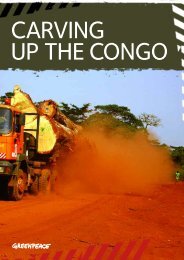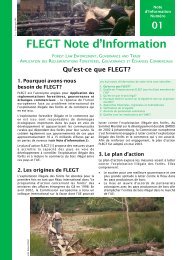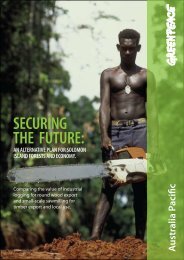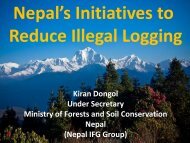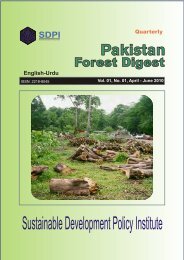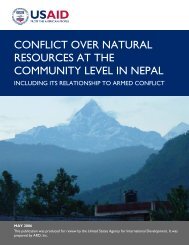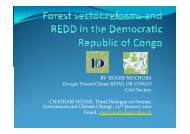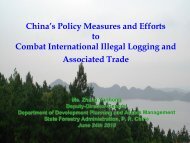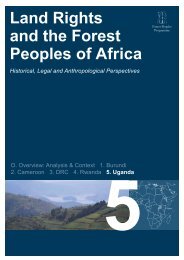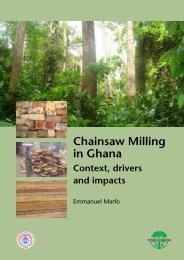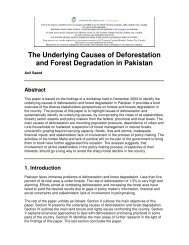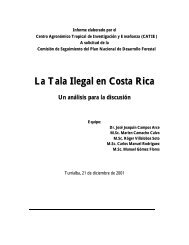THE SANTARÃM FIVE & ILLEGAL LOGGING â A CASE STUDY
THE SANTARÃM FIVE & ILLEGAL LOGGING â A CASE STUDY
THE SANTARÃM FIVE & ILLEGAL LOGGING â A CASE STUDY
You also want an ePaper? Increase the reach of your titles
YUMPU automatically turns print PDFs into web optimized ePapers that Google loves.
<strong>THE</strong> SANTARÉM <strong>FIVE</strong> & <strong>ILLEGAL</strong> <strong>LOGGING</strong><br />
– A <strong>CASE</strong> <strong>STUDY</strong><br />
October 2001 – Marcelo Marquesini/Gavin Edwards – Greenpeace Amazon<br />
In 1997 the Brazilian intelligence service SAE 1 estimated that about 80% of the logging in the Amazon is illegal in<br />
origin. For example companies operate on land that they do not legally own or use documents generated from<br />
legal management plans to cover logs from Indian lands where it is illegal to log. Latest figures from the Brazilian<br />
environmental agency IBAMA for 2000 show that there is about 4.5 million m 3 of wood authorised for logging under<br />
Forest Management Plans (FMP’s) in the Amazon, yet the annual wood extracted from the region is nearly 30<br />
million m 3 per year. Therefore despite various effforts to curb illegal logging, approximately 85% of the logging is<br />
still illegal 2 .<br />
Logging companies often make claims in the marketplace that they log sustainably, yet deforestation (land<br />
clearing, where forest is replaced by other land uses such as cattle grazing) continues in the Amazon and the trees<br />
from this clearing continue to supply the global market. Meanwhile customers around the world are continually<br />
assured that the wood they buy is from legal and sustainable sources. For example the UK Timber Trade<br />
Federation, in September 1993 signed an accord with AIMEX (the Para state timber exporters association) which<br />
committed local timber exporters to only export mahogany and cedar from sustainable sources and in strict<br />
compliance with pertinent Brazilian legislation. Given the high percentage of illegal logging it is clearly not possible<br />
for the vast majority of the wood finding its way into the marketplace to be legal and sustainable.<br />
This briefing investigates logging companies who are exporting the vast majority of wood from the port of Santarém<br />
in Para State in the eastern Amazon, and presents the evidence that all are involved in illegal and sometimes<br />
destructive logging. In particular it focuses on five companies that make up about 72% of the exports from<br />
Santarem – Cemex, Curuatinga, Estância Alecrim, Madesa & Rancho de Cabocla in 2000.<br />
Repeat Offenders – Santarém Companies Guilty of Illegal Logging<br />
In 1997 the Federal Prosecutor asked Greenpeace & IBAMA to investigate the 15 FMP’s for nine logging<br />
companies in the Santarém region 3 using data obtained from IBAMA, and extensive ground-truthing by a<br />
Greenpeace research team. The report noted various inconsistencies in the FMP’s, and 14 of the 15 plans were<br />
not being followed. For example Cemex produced a forest managment plan after completely making up an<br />
inventory of the amount of wood in a region, and then went on to ignore its plan by buildings roads that were not<br />
detailed in the plan, or cutting more wood than the volume authorized by the plan.<br />
After the report was released, the Federal Prosecutor investigated Cemex & Madesa and found illegalities in their<br />
land titles. IBAMA investigated Rancho Da Cabocla & Curuatinga and also found illegalities. IBAMA took the<br />
following action in 2001:<br />
Cemex - Three management plans, which amounted to 13,000ha in area, were cancelled. 4<br />
Madesa - Three management plans were suspended due to irregularities in their management plan, and one more<br />
management plan was cancelled. 5 The area amounted to 10,000ha.<br />
Curuatinga - One management plan was cancelled. 6<br />
Rancho Da Cabocla – Two management plans suspended, and one management plan will be cancelled. 7<br />
The companies produced a significant amount of wood from these plans in 2000 before the plans were cancelled<br />
or suspended. Logging also continued anyway in some of the FMP’s even after their cancellation<br />
1 Política Florestal: Exploração Madeireira na Amazônica. Secretaria de Assuntos Estratégicos (SAE). April 1997.<br />
2 Avalição dos planos de manejo florestal sustentável da Amazônia. IBAMA Brasília, DF. 2001.<br />
3 Parecer técnico sobre projetos de manejo florestal sustentado na região de Santarém/PA. Marcelo Marquesini/Greenpeace<br />
Amazon. 1997.<br />
4 Termo de compromisso de ajustamento de conduta contra Cemex’ Ministério Público Federal. 17th July 2001.<br />
5 Ação civil pública com pedido liminar de antecipação parcial da tutela contra Empresa Madesa – Madereira Santarém LTDA.<br />
Ministério Público Federal. 9th July 2001.<br />
6 Relatório sobre a situação dos projetos de manejo florestal no Para. IBAMA. April 2001.<br />
7 Relatório sobre a situação dos projetos de manejo florestal no Para. IBAMA. April 2001.<br />
Page 1
Illegal & Unsustainable Logging<br />
There are three main ways by which these logging companies obtain wood for milling and processing:<br />
1, Forest Management Plans (FMP’s).<br />
FMP’s are legal plans that allow for industrial logging in the Amazon. Since 1986, IBAMA has been issuing<br />
thousands of these plans, which help provide assurances to consumers that the industry is well regulated.<br />
However the plans themselves are often very weak, and frequently ignored. For example a 1996 report by<br />
government 8 showed a number of non-compliances with the law. It found that 93% of the FMP’s demonstrated no<br />
skid trails (where logs are removed from the forest), even though the careful location of these trails is essential to<br />
avoid damage to the forest and soil. A subsequent report by IBAMA 9 revealed that just 31% of the FMP’s were<br />
considered satisfactory. Forty percent of the plans were suspended and 22.6% were cancelled. Of the remaining<br />
plans, only 49% were deemed satisfactory by IBAMA. Even when a FMP is going to be cancelled, there is no<br />
guarantee that logging activities will cease. For example in the case of Madevi, in 1997 an IBAMA agent explained<br />
to a Greenpeace research team investigating illegal logging that he would cancel FMP number 3779/94 belonging<br />
to Madevi due to illegalities 10 . Yet IBAMA documents in 2000 show that Madevi still continue to log using this plan,<br />
and continue to submit relevant paperwork to IBAMA.<br />
2, Deforestation.<br />
Deforestation is defined as a logging operations where all the wood is removed from a given area, and the land<br />
then converted to other uses such as for cattle grazing. The Santarém companies continue to use wood derived<br />
from deforested areas even though more and more consumers around the world have made it clear that they do<br />
not want to buy wood that originates from such an unsustainable practice. Part of the reason for this is that the<br />
wood from deforested areas is much less expensive. For example Cemex pays 5 Reals (US$1.85) per m 3 for logs<br />
from deforested areas (from the Moju Project) compared to 25 Reals (US$9.25) per m 3 for the same quality of<br />
wood from FMP’s.<br />
3, Third Parties.<br />
Wood obtained from third parties such as other saw mills or logging companies can be illegal in numerous ways.<br />
For example some of the Santarém companies have been proven to obtain paperwork to legalize their wood from<br />
‘ghost companies’ – companies that produce paperwork for wood that does not exist in order to cover illegally<br />
logged wood. These ‘ghost companies’ are sawmills or wood traders who declare to IBAMA that a company has<br />
sold wood and/or logs to them, and have documents that verify this, but the company who sold the wood and/or<br />
logs does not declare this to IBAMA. Therefore the wood never existed, and the mill is generating the documents<br />
for the illegal wood that it never had in its possession. For example:<br />
Step 1: Company A obtains documents from company B to legalize illegal wood. The documents can come from<br />
legal and authorized logging operations, but where there is no logging (or even no wood).<br />
Step 2: Company A obtains the illegal wood.<br />
Step 3: Company A uses the legal documents to justify the illegal wood to IBAMA<br />
Step 4: Company B never declares to IBAMA that they supplied these documents/wood. IBAMA does not cross<br />
check the documents to confirm that company B has declared that they sold the wood.<br />
Step 5: Company A sells the sawn wood, which has now been legalized by the documents from company B, to<br />
wood traders/exporters.<br />
8 Diagnóstico dos projetos de manejo florestal no Estado do Pará – Fase Paragominas Relatório Preliminar. Embrapa/Cptau.<br />
Belém-Pará. Emprapa. 1996.<br />
9 Situação atual dos planos de manejo florestal sustentável na Amazônia Legal. Brasília, DF. Ibama. 1998.<br />
10 Parecer técnico sobre projetos de manejo florestal sustentado na região de Santarém/PA. Marcelo Marquesini/Greenpeace<br />
Amazon. 1997.<br />
Page 2
Year 2000 – Business As Usual<br />
The following examples of illegal and destructive logging are based on data obtained from IBAMA for year 2000:<br />
Cemex (Cemex Comercial Mad. Ltda.)<br />
Cemex officially exported 7,750 m 3 of wood in 2000 and 2,370 m 3 in Jan. to April 2001.<br />
The origin of their wood in 2000 was:<br />
17,600 cu.m from FMP’s. In 2000, Cemex sourced more than 50% of this from a Flona Tapajos (industrial logging<br />
concession). Cemex did not follow the FMP 11 . The rest was derived from illegal FMP’s that were cancelled by<br />
IBAMA 12 .<br />
2,300 m 3 from deforestation (land clearing).<br />
567 m 3 from other small saw mills. Two of the saw mills are ghost companies (Zeno Industrial in 2000 & J.S.<br />
Madeplacas in 2001). 13<br />
Madesa (Madeireira Santarém Ltda.)<br />
Madesa officially exported 7,600 m 3 of wood in 2000 and 2,600 m 3 in Jan. to April 2001.<br />
The origin of their wood in 2000 was:<br />
16,800 cu.m from a FMP. Madesa derived all of this from a FMP that was cancelled by IBAMA in July 2001, as the<br />
plans were found to be based on logging of public lands, which is illegal. 14<br />
zero from deforestation (land clearing).<br />
zero from other small saw mills<br />
Curuatinga (Industrial Madeireira Curuatinga Ltda.)<br />
Curuatinga officially exported 8,600 m 3 of wood in 2000 and 5,300 m 3 in Jan. to April 2001.<br />
The origin of their wood in 2000 was:<br />
15,600 cu.m from five FMP’s operated by third party suppliers in the Porto de Móz region, and one FMP operated<br />
directly by Curuatinga. Three FMP’s were suspended in April 2001 by IBAMA. 15 One of Curuatinga’s third party<br />
suppliers is the Porto de Móz saw mill, who buy wood from local loggers. The sawmill was fined for being in<br />
possession of over 800 m 3 of wood worth $32,500US in March 2001. As recently as September 2001 they<br />
received another fine in relation to illegal logging, for wood that had no legal documents.<br />
zero from deforestation (land clearing).<br />
zero from other small saw mills<br />
Rancho da Cabocla (Maderieira Rancho do Cabocla Ltda.)<br />
Rancho da Cabocla officially exported 14,800 m 3 in 2000 and 5,230 m 3 in Jan. to April 2001.<br />
The origin of their wood in 2000 was:<br />
19,650cu.m from a mix of two FMP’s and seven deforestation authorisations. 16<br />
2,414 m 3 from other small saw mills. Two of the saw mills are ‘ghost companies’ (Zeno Industrial & Itamex). 17<br />
Estância Alecrim/Milton José Schnorr<br />
Estância Alecrim was founded in 1999. It officially exported 4,502 cu.m in 2000, and 1,397 m 3 in Jan. to Apr. 2001<br />
The origin of their wood in 2000 was:<br />
11,247 m 3 from a mix of three FMP’s and 26 suppliers from deforestation. 18<br />
521 m 3 from other small saw mills. Two of the saw mills are ‘ghost companies’ (J.S.Madeiras/Madeplacas, Zeno<br />
Industrial & Itamex/Madeira do Gareira). 19<br />
11 Flona Tapajós – Histórico e situação atual da Flona Modelo. Greenpeace Amazon. Sept. 2001.<br />
12 Relatórios Mensais de entrada e saída de madeira em toras. IBAMA. 2000.<br />
13<br />
Empresas fantasmas e madeira ilegal em Santarém – relatório técnico. Greenpeace Amazon. Sept. 2001.<br />
14 Relatórios Mensais de entrada e saída de madeira em toras. IBAMA. 2000.<br />
15 Relatórios Mensais de entrada e saída de madeira em toras. IBAMA. 2000.<br />
16 Relatórios Mensais de entrada e saída de madeira em toras. IBAMA. 2000.<br />
17 Empresas fantasmas e madeira ilegal em Santarém – relatório técnico. Greenpeace Amazon. Sept. 2001.<br />
18 Relatórios Mensais de entrada e saída de madeira em toras. IBAMA. 2000.<br />
19 Empresas fantasmas e madeira ilegal em Santarém – relatório técnico. Greenpeace Amazon. Sept. 2001.<br />
Page 3
Global Demand for Wood is Fuelling the Chainsaws<br />
Much of the wood produced in the Santarém region is exported, in particular to Europe. The wood is handled by a<br />
variety of importers, the largest being DLH / Nordisk which accounts for almost 13% of the exports from Sanatarém<br />
and sells the wood in Belgium, Denmark, China, UK, France, Germany, Netherlands, Portugal, Spain and the USA.<br />
Species exported include Ipé and Jatoba, and has a variety of uses such as hardwod flooring and decking.<br />
Selected Wood Exports from Santarém, Jan. 2000 to Apr. 2001 20<br />
Country of Export<br />
Cubic metres<br />
The Netherlands<br />
22,681<br />
Ireland<br />
USA<br />
UK<br />
Germany<br />
Switzerland<br />
China<br />
The Netherlands<br />
France<br />
19,297<br />
Portugal<br />
Spain<br />
8,909<br />
Denmark<br />
6,599<br />
Belgium<br />
Denmark<br />
Spain<br />
France<br />
Belgium<br />
5,626<br />
Portugal<br />
5,509<br />
Ireland<br />
4,644<br />
USA<br />
4,574<br />
UK<br />
1,457<br />
Germany<br />
634<br />
Switzerland<br />
406<br />
China<br />
101<br />
The Solutions<br />
Greenpeace Global Call for Action:<br />
In order to halt the destruction of ancient forests worldwide, Greenpeace is calling on the 180 governments<br />
formally committed to the Convention on Biological Diversity (CBD) for a moratorium on logging and other<br />
industrial activities in all the world’s remaining large areas of ancient forests, until representative protected area<br />
networks and areas of sustainable use are fully established, and to create a global ancient forest fund of at least<br />
US$15 billion annually to fund implementation of these measures.<br />
20 Mapa Mensal das exportações de produtos e sub-produtos florestais. IBAMA/Santarém. Jan. 2000 to Apr. 2001.<br />
Page 4
Greenpeace calls to action to the Brazilian Government:<br />
Moratorium:<br />
• Greenpeace is calling for an immediate moratorium on all industrial logging in the Middle Land until a full<br />
assessment of the ecological values of this area can be completed and a credible land use plan developed<br />
and implemented.<br />
Measures:<br />
• IBAMA should permanently revoke all Forest Management Plans held by companies found laundering<br />
illegal logs<br />
• Forest Stewardship Council (FSC) is an eco-certification scheme that has global acceptance in the<br />
marketplace. It employs a chain of custody scheme which tracks wood from the forest to the consumer, so<br />
that the exact origin of the wood is known. It also does not certify deforestation. As such, it is the best<br />
protection against illegal and destructive logging, and Greenpeace is calling on all logging companies to<br />
become FSC certified within four years.<br />
Money:<br />
• Additional funding and resources should be made available to IBAMA so that they can more effectively<br />
carry out their role of monitoring and enforcing Brazilian environmental laws.<br />
• Additional funding and resources should be allocated for improved tropical forest research, environmental<br />
education, training of forest managers and development of economic alternatives in local communities.<br />
Page 5




